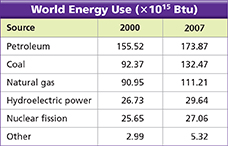Renewable Energy Resources
Renewable energy resources are resources that can be replaced in a relatively short period of time. Most renewable energy resources originate either directly or indirectly from the sun. The sun and Earth are constantly releasing large amounts of energy. This energy can be used for generating electric power, heating buildings or other purposes.  Renewable energy resources include hydroelectric, solar, geothermal, wind, biomass, and, possibly in the future, nuclear fusion. The challenge for engineers and scientists is to find efficient ways to make these energy resources inexpensive and convenient.
Renewable energy resources include hydroelectric, solar, geothermal, wind, biomass, and, possibly in the future, nuclear fusion. The challenge for engineers and scientists is to find efficient ways to make these energy resources inexpensive and convenient.
Hydroelectric Energy
Energy obtained from flowing water is known as hydroelectric energy. Hydroelectric energy is an indirect form of solar energy. Energy from the sun causes evaporation of water, which later falls back to Earth as precipitation. The water from this precipitation often collects to form rivers. As river water flows downhill, its gravitational potential energy is converted into kinetic energy. This kinetic energy can be used to turn turbines that are connected to electric generators in a power plant, such as the one shown in Figure 17. The major advantages of hydroelectric energy include its low cost to produce and lack of pollution. Dams, however, cause a variety of environmental problems. For example, dams hamper the run of fish upriver for spawning. Also, in the United States, many of the most suitable sites for hydroelectric plants are already in use.
Figure 17 Hoover Dam was built across the Colorado River on the Arizona-Nevada border. This 221-meter-tall structure can generate over 2 million kilowatts of power. Applying Concepts What type of energy conversion is involved in a hydroelectric plant?

Data Analysis
World Energy Use
Which energy resources are most commonly used around the world? How is energy use changing over time? The table shows total world energy use in 2000 and 2007. Energy use can be measured in British thermal units, or Btu (1 Btu 5 1055 J). Note that petroleum includes oil and related fuels.
Using Tables What was the world's largest source of energy in 2000? In 2007?
Analyzing Data In general, how did usage change from 2000 to 2007?
Graphing Make a circle graph of world energy use by source for the year 2007.
Analyzing Data What percentage of world energy use in 2007 was accounted for by fossil fuels?
Predicting How might total world energy use be different in 2020? Explain.





